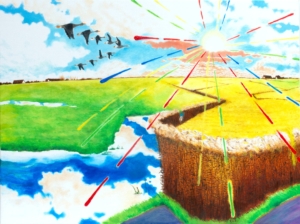Generative imagination
Extending David Bohm & David Peat’s notion of generative order*, we introduce the following definition:
generative imagination (1)
= imagination necessary to actually perceive, create or bring to life a generative order
generative imagination (2)
= imagination capable of generating new orders;
the potential quality of human consciousness with which one can profoundly participate in the generation of one’s reality (and in the generation of the shared reality within one’s culture/society).
This means imagining not only artistically but also as a way of being in and with the world, effectively impacting perception and ways of thinking.
From explicate to generative imagination
Ordinary perception usually pretty much boils down to ‘explicate and replicative imagination’, meaning that the perceived, shared reality unfolds automatically/mechanically in consciousness i.e. perception predominantly falls back on memory, habituated patterns, tacit cultural and personal knowledge. The same dull patterns get repeated, replicated. The ubiquity of photography plays a significant role in this. The capacity to look afresh is still there, albeit underneath the calcifications of habit – stored patterns and images. Only when something really stands out from the regular, this mostly unconscious system gets shook and one needs to reconsider one’s perception. Feelings of awe or fear come up, usually very briefly, before an appropriate, pacifying image replaces and dulls the experience.
Now, it is possible to move one’s attention ‘upstream’, toward the more generative order out of which ordinary perception flows.
As a result, imagination can become more and more generative in nature, i.e. one is able to look at the world afresh, beyond labels, internalized patterns and stored knowledge.
In this fashion, certain aspects of the universe in flux (holoflux) may reveal themselves spontaneously, altering the reality that unfolds.
In other words, awareness is capable of more deeply participating in the imagining process, consciously unfolding the aspects it deems relevant.
Hence, imagination can move upstream and become much more generative, temporarily or permanently, and thus a more creative outlook can ensue.
Different modes and qualities of imagination & creativity
When it comes to artistic creativity, the quality of imagination can vary between explicate (e.g. photorealism), ‘replicative’ (e.g. lens-based art, hyperrealism and most post-modern photography-based painting) and generative (e.g. most abstract art, certain figurative art, inscendental art, …). A mixed variety is also possible of course in a work of art or a body of work.
Art movements such as Impressionism, Cubism are mainly preoccupied with awareness of aspects involving explicate imagination, replicating some of these aspects, uncovering generative orders that were hitherto hidden or unexplored.
To our knowing, art forms that go farther upstream, examining the generation of space and time, are largely unexplored.
Cézanne to this day is one of the few artists known for his work in that direction.
David Hockney’s later periods are also a great example of generative imagination at play.
Related concepts
- Goethe’s dynamic way of seeing
- Coleridge’s esemplastic (unifying) power of imagination
- J. Krishnamurti’s direct perception (“looking afresh”)
Recommended reading
“Wholeness, timelessness & unfolding” David Bohm interview (Beshara magazine)
“Lost knowledge of the imagination” Gary Lachman, 02017, Floris Books
“Ancient Indian texts reveal the liberating power of metaphysics” Jessica Frazier, 02022 (Psyche.co)
Note on my artwork and role of the body
Most of my artwork stems from generative imagination firmly rooted in the body, meaning that my creativity is embodied and inspired by both bodily and mental intuitions.
This also enables me to create in a wide variety of styles from within. Style is subservient to the unfolding meaning of the picture, and can be seen as ‘relevated aspect Gestalts’.
Imagination always involves a more physical/somatic component, but this can wildly vary. Abstract art, for example, in most cases, is largely a mental affair.
More on this: the body – embodiment
* Generative order
“[Generative order] is concerned with a deeper and more inward order out of which the manifest form of things can emerge creatively.
Indeed this order is fundamentally relevant both in nature and in consciousness. “
“Science, Order & Creativity” (2nd edition), p. 151, David Bohm & F. David Peat
 A simple example would be the order of fractals: simple mathematical equations give rise to very complex patterns, e.g. those seen in romanesco broccoli.
A simple example would be the order of fractals: simple mathematical equations give rise to very complex patterns, e.g. those seen in romanesco broccoli.
A more complex example can be the generative order of a painting: the hidden creative source/logic/intuitions of a work of art that determined each part/line/stroke/… executed by the artist. To visually *get* a painting is to realize/recreate its generative order. (necessary factor: generative imagination)
Frequently Asked Questions
Does generative imagination have anything to do with generative AI?
Our proposal of generative imagination is focused on human and embodied imagination, informed by all senses and sensitivities, which has different qualities than the image-generating capacities of AI.
Artificial Intelligence (or is it Artificial Stupidity?) can only fall back on existing data and learning algorithms. They can be very interesting, quite creative even, sometimes generative at a deeper level, but technology has its limits. For example, Mandelbrot renderings are generative in nature and can be jaw-dropping, but their meaning is fairly limited.
We are not against AI or AI-generated art. It is our view that human-made art needs to focus on its natural strengths instead of trying to emulate photography and getting trapped in fixed styles and meaningless abstraction. It is by incorporating our full humanity and creativity that new and exciting art can unfold, with deep meaning and penetrating questions. Human beings are capable of seeing and feeling the world in ways machines never will.


